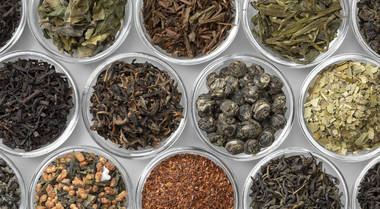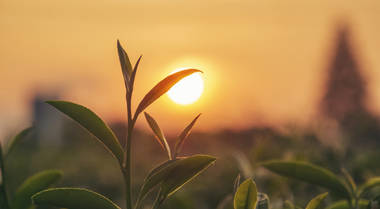What is Tea Oxidation? How It Impacts Aroma and Flavor
September 12, 2025

How a Simple Process Transforms Your Brew
Let's Talk Oxidation
Ever noticed how a sliced apple turns brown in minutes? That's oxidation at work, and your tea leaves go through a similar transformation. Oxidation is one of the key reasons green tea tastes grassy and delicate, while black tea is rich and bold. Understanding it is key to unlocking so many of tea's joy. You start seeing (and tasting) all the layers that were hiding in your cup. This article will walk you through how oxidation shapes every sip, why it matters, and how it's one of the oldest and tastiest scientific processes around.What Is It?
Oxidation in tea is a fancy way of saying the leaves are reacting with oxygen. When leaves are bruised, broken, or left out before firing, enzymes in the leaf meet oxygen and kick off a flavor makeover. Sort of how a banana or avocado darkens. But let's be clear about one thing: oxidation is not fermentation (that's a whole other process). This one's just about oxygen doing its magic, depending on what you want. This simple reaction is what gives us tea's entire flavor spectrum.Tea Styles from Light to Dark
Here's the cool part: how much a tea is oxidized determines everything about your brew.
• Green Tea (0–10%)
Green tea is the least oxidized of the bunch, which is why its flavors stay so fresh and grassy. Imagine biting into a crisp cucumber or munching on fresh sugar snap peas. That's the kind of refreshing quality green tea often has.
Japanese Sencha leans toward a savory, seaweed-like taste (think nori snacks), while Chinese dragonwell can have a soft chestnut sweetness. Because these teas are delicate, brewing them too hot can make them bitter. In other words, they're happiest in cooler water, like you'd use for poaching delicate fish.

• White Tea (0–5%)
White tea sits close to green tea on the oxidation spectrum but is processed even more gently. The flavor is subtle and sweet, like biting into a perfectly ripe pear or tasting a drop of honey straight from the comb.
Fujian Silver Needle, for example, is floral and light, almost like spring water with a hint of meadow blossoms. It's a tea you sip slowly, the way you'd savor a soft piece of angel food cake.

• Oolong (10–80%)
Oolong is where things get interesting. It spans a wide range of oxidation levels, which means its flavors can swing from bright and floral to rich and toasty.
A lightly oxidized oolong like our Milk Oolong might remind you of biting into a fragrant peach or smelling a bouquet of lilacs. On the other hand, a heavily oxidized oolong (like Formosa Bai Hao can bring to mind roasted hazelnuts or the sweet, almost caramelized taste of baked apples.
Think of it like the jazz musician of tea: complex, expressive, and often surprising.

• Black Tea (80–100%)
Fully oxidized black teas are robust and warming. If green tea is like a crisp salad, black tea is more like fresh-baked bread or a dark chocolate brownie. It's hearty, rich, and deeply satisfying.
An Assam might taste malty, like warm toast with a touch of molasses, while a Darjeeling can offer muscatel notes reminiscent of grapes and red wine. These teas hold up well to milk and sugar, making them a cozy choice on cooler days.

• Pue-Erh & Dark Teas (varied oxidation + fermentation)
Pu-erh teas are in a category of their own because they're fermented after oxidation, creating earthy, grounding flavors. Think forest floor after rain, dark cocoa, or the deep richness of dried figs.
Shou (ripe) Pu-erh leans into these dark, sweet, almost coffee-like notes, while Sheng (raw) Pu-erh can be more lively and herbaceous in its youth, mellowing into a complex aged profile over time.
Next time you pour, think of each sip as a snapshot on a flavor timeline shaped by how much that leaf was left to "color" in before hitting your cup.

The Flavor Chemistry Behind It
Here's a little taste of the chemistry: When tea oxidizes, the natural polyphenols in the leaves transform into compounds called theaflavins and thearubigins. These guys are what give oxidized teas their color, aroma, and that fuller mouthfeel. That slight astringency you notice in black teas? That's thanks to these new compounds. And drying produces all those toasty, caramel, and fruity notes you smell. What's really cool is how these flavor shifts trace back to simple oxygen exposure. It's chemistry, but also kind of magic.How Tea Makers Work with Oxidation
Speaking of magic, you can then think of tea producers as wizards, in a way. They use techniques like withering, rolling, and timing to control oxidation. Want something light and vegetal? You stop oxidation fast. Craving a deeply dark, bold cup? You let it go a little longer. Places like Taiwan are famous for tightly controlled oolongs, where each wave of oxidation brings something unique. In Darjeeling, that precious "second flush" tea comes with a sweeter, more muscatel character thanks to careful oxidation control. It's all a dance of air, heat, and timing.How to Taste Oxidation
Next time you're trying a new tea, take a slow sip. Notice how a green tea stays bright, how an oolong shifts from floral to toasty across steeps, or how a black tea's roundness warms your mouth. Let your taste buds notice those transitions. Doing this is what makes you a more observant tea drinker.So there it is: oxidation is the unsung hero behind the flavors you love. By stopping or slowing oxidation at precise times, tea makers craft everything from grassy whites to bold blacks. The next time you sip, you'll taste not just tea, but a process, a journey, and a bit of art. Ready to explore more? Pick up teas across the oxidation scale—green, oolong, and black—and taste the difference for yourself. You might just discover your new favorite.